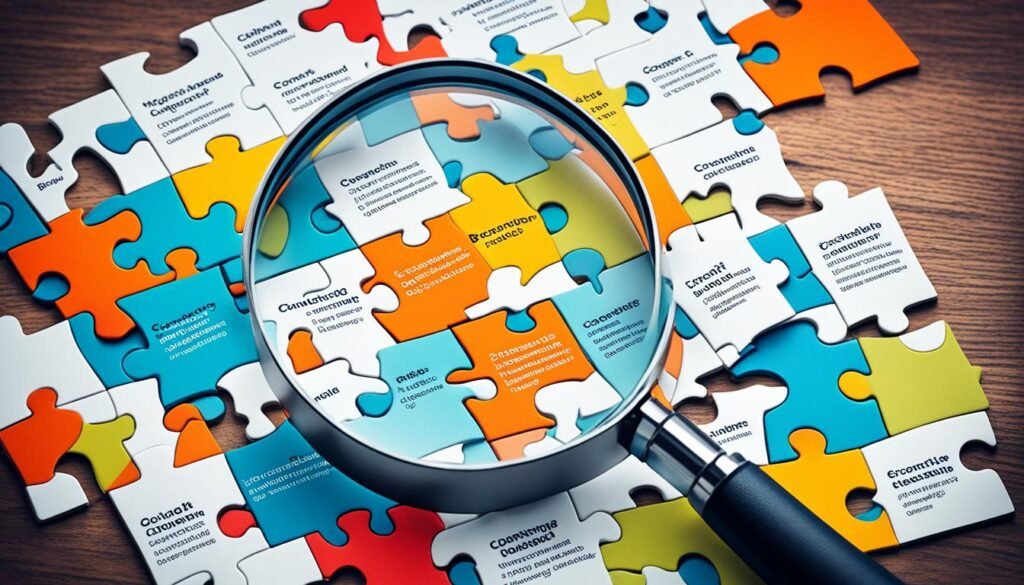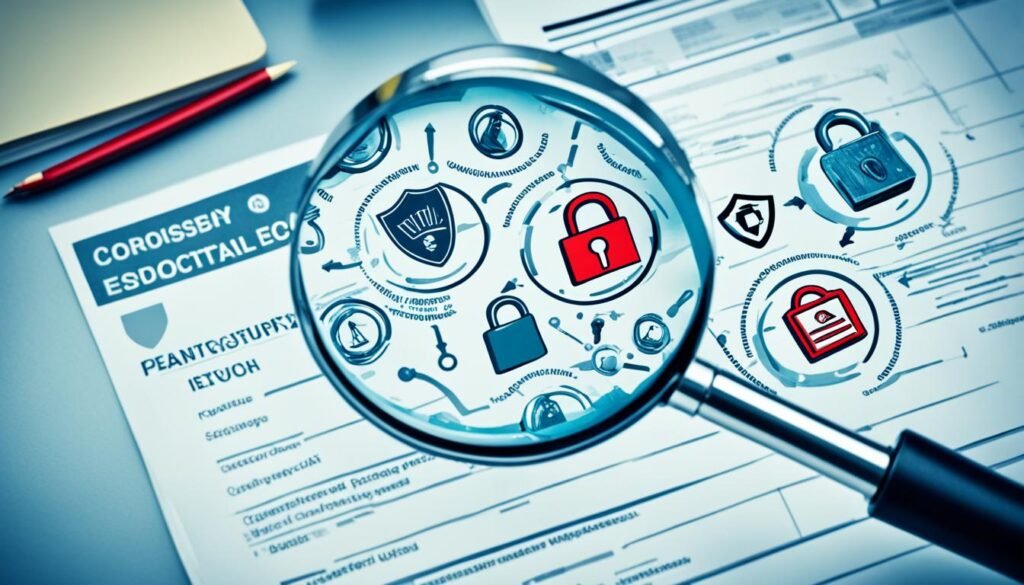Did you know that 68% of small businesses have faced a big disaster that threatened their work1? All businesses, no matter their size or type, deal with risks that could be very harmful if not handled right. These risks include physical threats like fires and location disasters, as well as human issues like theft and fraud12.
It’s key to spot and manage risks to keep your business safe for the long run. By looking ahead and figuring out the risks your business might face, you can make plans to protect your work, stuff, and good name2.
Key Takeaways
- Businesses face many risks, like physical, location, human, tech, and strategic threats.
- Spotting and managing risks is vital for keeping your business going and protecting your profits.
- Assessing risks and making plans to lessen their impact can help protect your business.
- Talking to your team and customers can give you insights into risks you might not see.
- Good risk management is a key part of planning for your business’s future.
The Importance of Risk Identification and Management
Identifying and managing risks is key to a business’s long-term success and stability. Risks can come from many places, like financial issues, legal problems, mistakes in strategy, accidents, and natural disasters3. By being proactive, businesses can stop risks before they start or lessen their effects3.
Risks That Can Destroy a Business
Small businesses face big risks because they often don’t have as many resources as big companies4. By spotting and planning for risks, small businesses can stay strong and succeed even when things get tough3. This approach helps with strategic planning, builds trust with stakeholders, and leads to smarter decisions3.
Key Strategies for Managing Risks
Good risk management means following a clear process. This includes making a risk statement, identifying risks, checking them, and finalizing the plan3. Businesses can use many ways to find risks, like brainstorming, talking to team members and customers, using online tools, and doing analyses3. These methods help businesses understand threats and plan how to deal with them43.

Being proactive and thorough is the secret to managing risks well. By tackling risks early, businesses can be more resilient, gain trust, and make better choices to overcome challenges3.
“Risk identification is the first and critical stage of the risk management process.”3
Identifying and Managing Potential Business Risks
Successful businesses must tackle potential risks head-on to stay stable and grow5. These risks can be many, like losing profits or facing external problems6.
External risks, like not being able to trade, can really hurt a business6. Internal risks, like tech failures, can also be big problems6.
To handle these risks, businesses use scales to see how big they are6. This helps them focus on the biggest threats and act fast6.
Using market reports and safety guides can help spot risks6. It’s smart to plan for the worst and have backup plans6.

Being proactive with risk management is key to success5. By knowing the risks and making smart choices, companies can avoid big losses5.
| Risk Type | Examples | Potential Impacts |
|---|---|---|
| Compliance Risks | Violations of laws and regulations | Legal trouble and damage to reputation7 |
| Operational Risks | Errors and fraud, natural disasters | Threats to making money7 |
| Reputational Risks | Bad publicity, product recalls | Damage to brand and trust7 |
| Strategic Risks | Failed projects, bad investments | Bad effects on business plans7 |
| Financial Risks | Issues with cash flow and assets | Hard to cover costs and stay profitable7 |
| Credit Risks | Clients not paying on time | Lost income and financial strain7 |
| Technology/Cybersecurity Risks | Power outages, equipment damage, cyber threats | Disruption to daily work7 |
| Competitive Risks | Not being competitive | Struggling to keep up with changes7 |
| Human Risks | Sickness, fraud, addiction | Disruptions to work7 |
| Physical Risks | Damage to buildings or equipment | Caused by fires or accidents7 |
“Identifying and managing potential business risks is crucial for long-term success. By proactively addressing a wide range of threats, organizations can protect their bottom line and maintain a competitive edge.”
By carefully looking at risks and planning for them, businesses can grow and stay strong over time. Using resources, making smart plans, and watching for new threats helps keep an organization strong.
Conducting a Risk Assessment
Doing a detailed risk assessment is key to identifying and managing potential business risks8. It means looking closely at the organization, using tools and software, and getting feedback from employees and customers8. By looking at financial statements, industry research, and data, businesses can figure out the risks they face. They can then sort and tackle these risks with the right risk mitigation strategies8.
Breaking Down the Big Picture
When looking at risks, many risks can be found for each goal, showing how many dangers a business might face8. It’s important to think about internal and external risk factors when spotting risks that could stop business goals8. Managers should actively manage risks to avoid surprises and help meet goals8.
Leveraging Risk Assessment Tools
High-risk transactions like cash handling, equipment moves, payroll, and travel need extra attention8. Risk analysis looks at how likely and big a risk is, covering both the numbers and the human side for a full check8. Prioritizing risk management helps focus on the big risks, especially those that could happen often and have a big effect8.
| Risk Assessment Tool | Description |
|---|---|
| HAZID (Hazard Identification) Studies | Uses guide words and checklists to find potential dangers, causes, and effects. Helps figure out how severe and likely a hazard is9. |
| Risk Assessment Matrices and Heat Maps | Tools to compare and rank hazards by likelihood and severity. Decision-makers can see which risks need more focus9. |
| LOPA (Layer of Protection Analysis) | Checks if barriers in place or planned can keep risk at acceptable levels9. |
| Bow-Tie Risk Analysis | Looks at a specific dangerous event from all angles, covering causes, controls, and effects9. |
Seeking Employee and Customer Feedback
Risk assessment tips include having a clear mission and goals for a department, checking risks at different levels, and focusing on key areas for betterment8. The complexity and rules of an activity can affect its risk level, so risk management strategies need to be specific8. Looking closely at risks at the department level is key to tackling all risks well and reducing their impact on the business8.
“A thorough risk analysis means guessing the chance and effect of risks, helping make decisions on how to manage risks and use resources.”8
Strategies for Risk Mitigation
Managing business risks is key to keeping a company safe and successful10. Risk mitigation means taking steps to lessen the chance of risks that could hurt your business10. You can do this by using internal controls, spreading out your investments, getting insurance, or having backup plans10. The goal is to keep risks from hurting your business and protecting your money10.
There are seven main ways to handle business risks: accept it, avoid it, challenge it, prioritize it, control it, transfer it, and keep track of it11. Risk management means looking at risks to see how likely they are and how they could affect your business11. A risk heat map helps show how big the impact could be for different risks11.
Why is risk mitigation important? It keeps your company safe, protects your reputation, and keeps your finances stable10. It helps you avoid big problems and get ready for challenges10. The main goals are to lessen risks, make better decisions, use resources well, and be more resilient10.
Risk mitigation makes your business more flexible and ready for surprises10. It helps you plan for risks, prepare better, and keep innovating10. It also makes sure your risk level matches your business goals11. Keeping track of risks is key to fixing problems fast11.
| Risk Mitigation Strategy | Description |
|---|---|
| Risk Acceptance | Acknowledging and accepting potential consequences when the cost of mitigating the risk outweighs benefits, likelihood is low, and impact is manageable10. |
| Risk Avoidance | Eliminating or withdrawing from activities or situations presenting unacceptable levels of risk, used when consequences are severe, likelihood high, and risks not aligned with objectives10. |
| Risk Mitigation | Taking proactive steps to reduce the likelihood or impact of identified risks, involving identifying potential risk events, developing and implementing controls, and monitoring effectiveness10. |
Top strategies for handling risks include acceptance, avoidance, mitigation, reduction, and transfer10.
“Proactive risk management is essential for businesses to navigate uncertainties and safeguard their long-term success.”
Conclusion
Identifying and managing potential business risks is key to success. It needs constant attention and a proactive mindset. By knowing the risks like strategic risk, compliance risk, operational risk, and reputational risk12, doing deep risk assessments, and using strong risk mitigation strategies, you can keep your assets safe. This helps ensure your business thrives and stays strong for the future12.
Businesses that focus on risk management can handle surprises better and stay ahead in the market13. Good risk management also helps with building strong relationships and cutting costs13. By having emergency management plans, keeping track of suppliers, listening to customers, and checking your business often, you can lessen the effects of uncertainty-based risks13.
As you work on identifying and managing potential business risks, remember it’s crucial. By using enterprise risk management, operational risk analysis, strategic risk monitoring, and compliance risk evaluation, you set your business up for long-term success14. With help from experienced lawyers at BusinessLawyersIrvine.com and Super Attorneys Of Irvine, you can handle risk management well. This ensures your business keeps growing and doing well.
FAQ
What are the different types of business risks?
Why is conducting a risk assessment crucial for identifying and managing potential business risks?
What are the two primary methods for managing business risks?
Why is identifying and managing potential business risks an ongoing process?
Source Links
- https://www.investopedia.com/articles/financial-theory/09/risk-management-business.asp
- https://riskonnect.com/risk-management-information-systems/a-guide-to-understanding-identifying-and-managing-business-risks/
- https://datamyte.com/blog/risk-identification/
- https://safetyculture.com/topics/risk-identification/
- https://www.forbes.com/sites/melissahouston/2023/01/11/risk-management-for-your-business-what-you-need-to-know/
- https://www.business.qld.gov.au/running-business/risk/identify-manage
- https://www.capitalone.com/learn-grow/business-resources/identifying-and-managing-business-risks/
- https://www.finance.ucla.edu/corporate-accounting/controls-and-accountability/control-practices/how-to-assess-risk
- https://www.assp.org/news-and-articles/conducting-a-risk-assessment
- https://www.solvexia.com/blog/5-types-of-risk-mitigation-strategies
- https://www.techtarget.com/searchcio/feature/7-risk-mitigation-strategies-to-protect-business-operations
- https://www.investopedia.com/terms/b/businessrisk.asp
- https://business.gov.au/risk-management/risk-assessment-and-planning/business-risks
- https://hbr.org/2012/06/managing-risks-a-new-framework

